Estimation of Unmeasured Room Temperature, Relative Humidity, and CO2 Concentrations for a Smart Building Using Machine Learning and Exploratory Data Analysis
Abstract
:1. Introduction
- Reduced number of sensors required for optimal indoor environment variable measurements in a commercial building.
- Accurate indoor temperature and relative humidity estimation for HVAC system control to reduce energy waste while improving occupant thermal comfort.
2. Materials and Methods
2.1. XGBoost Machine Learning Algorithm
2.2. Methodology
2.2.1. Data Collection and Pre-Processing
2.2.2. Data Analysis and Input Feature Selection
2.2.3. XGBoost Model Design, Training, Testing, and Evaluation
3. Results
3.1. Indoor Temperature Estimation Results
3.2. Relative Humidity and CO2 Concentration Estimation Results
4. Discussion
5. Conclusions
Author Contributions
Funding
Institutional Review Board Statement
Data Availability Statement
Acknowledgments
Conflicts of Interest
References
- Frontczak, M.; Wargocki, P. Literature survey on how different factors influence human comfort in indoor environments. Build. Environ. 2011, 46, 922–937. [Google Scholar] [CrossRef]
- Heinzerling, D.; Schiavon, S.; Webster, T.; Arens, E. Indoor environmental quality assessment models: A literature review and a proposed weighting and classification scheme. Build. Environ. 2013, 70, 210–222. [Google Scholar] [CrossRef] [Green Version]
- Al Horr, Y.; Arif, M.; Kaushik, A.; Mazroei, A.; Katafygiotou, M.; Elsarrag, E. Occupant productivity and office indoor environment quality: A review of the literature. Build. Environ. 2016, 105, 369–389. [Google Scholar] [CrossRef] [Green Version]
- Provins, K.A. Environmental heat, body temperature, and behavior: An hypothesis. Aust. J. Psychol. 2007, 18, 118–129. [Google Scholar] [CrossRef]
- Rezaie, B.; Rosen, M.A. Department of Environment and Energy HVAC Energy Breakdown. HVAC Hess 2013, 93, 36–37. [Google Scholar]
- Manic, M.; Amarasinghe, K.; Rodriguez-Andina, J.J.; Rieger, C. Intelligent Buildings of the Future: Cyber aware, Deep Learning Powered, and Human Interacting. IEEE Ind. Electron. Mag. 2016, 10, 32–49. [Google Scholar] [CrossRef]
- Weng, T.; Agarwal, Y. From buildings to smart buildings-sensing and actuation to improve energy efficiency. IEEE Des. Test Comput. 2012, 29, 36–44. [Google Scholar] [CrossRef]
- Batov, E.I. The distinctive features of “smart” buildings. Procedia Eng. 2015, 111, 103–107. [Google Scholar] [CrossRef] [Green Version]
- Crawley, D.B.; Lawrie, L.K.; Winkelmann, F.C.; Buhl, W.F.; Huang, Y.J.; Pedersen, C.O.; Strand, R.K.; Liesen, R.J.; Fisher, D.E.; Witte, M.J.; et al. EnergyPlus: Creating a new-generation building energy simulation program. Energy Build. 2001, 33, 319–331. [Google Scholar] [CrossRef]
- Chen, X.; Li, X. Virtual temperature measurement for smart buildings via Bayesian model fusion. Proc.-IEEE Int. Symp. Circuits Syst. 2016, 2016, 950–953. [Google Scholar] [CrossRef]
- Ghahramani, A.; Galicia, P.; Lehrer, D.; Varghese, Z.; Wang, Z.; Pandit, Y. Artificial Intelligence for Efficient Thermal Comfort Systems: Requirements, Current Applications, and Future Directions. Front. Built Environ. 2020, 6, 109807. [Google Scholar] [CrossRef]
- Dong, B.; Prakash, V.; Feng, F.; O’Neill, Z. A review of a smart building sensing system for better indoor environment control. Energy Build. 2019, 199, 29–46. [Google Scholar] [CrossRef]
- Han, Z.; Gao, R.X.; Fan, Z. Occupancy and indoor environment quality sensing for smart buildings. In Proceedings of the 2012 IEEE International Instrumentation and Measurement Technology Conference Proceedings, Graz, Austria, 13–16 May 2012; pp. 1–6. [Google Scholar]
- Wei, Y.; Zhang, X.; Shi, Y.; Xia, L.; Pan, S.; Wu, J.; Han, M.; Zhao, X. A review of data-driven approaches for prediction and classification of building energy consumption. Renew. Sustain. Energy Rev. 2018, 82, 1027–1047. [Google Scholar] [CrossRef]
- Bouktif, S.; Fiaz, A.; Ouni, A.; Serhani, M.A. Optimal deep learning LSTM model for electric load forecasting using feature selection and genetic algorithm: Comparison with machine learning approaches. Energies 2018, 11, 1636. [Google Scholar] [CrossRef] [Green Version]
- Amarasinghe, K.; Marino, D.L.; Manic, M. Deep neural networks for energy load forecasting. In Proceedings of the 2017 IEEE 26th International Symposium on Industrial Electronics (ISIE), Edinburgh, UK, 19–21 June 2017; pp. 1483–1488. [Google Scholar] [CrossRef]
- Kaligambe, A.; Fujita, G. Short-Term Load Forecasting for Commercial Buildings Using 1D Convolutional Neural Networks. In Proceedings of the 2020 IEEE PES/IAS PowerAfrica, Nairobi, Kenya, 25–28 August 2020. [Google Scholar] [CrossRef]
- He, K.; Zhang, X.; Ren, S.; Sun, J. Delving deep into rectifiers: Surpassing human-level performance on imagenet classification. In Proceedings of the IEEE International Conference on Computer Vision, Santiago, Chile, 7–13 December 2015; pp. 1026–1034. [Google Scholar] [CrossRef] [Green Version]
- Zhang, X.; Pipattanasomporn, M.; Chen, T.; Rahman, S. An IoT-Based Thermal Model Learning Framework for Smart Buildings. IEEE Internet Things J. 2020, 7, 518–527. [Google Scholar] [CrossRef]
- Aliberti, A.; Ugliotti, F.M.; Bottaccioli, L.; Cirrincione, G.; Osello, A.; MacIi, E.; Patti, E.; Acquaviva, A. Indoor Air-Temperature Forecast for Energy-Efficient Management in Smart Buildings. In Proceedings of the 2018 IEEE International Conference on Environment and Electrical Engineering and 2018 IEEE Industrial and Commercial Power Systems Europe (EEEIC/I&CPS Europe), Palermo, Italy, 12–15 June 2018. [Google Scholar] [CrossRef]
- Chen, X.; Li, X.; Tan, S.X.D. Overview of cyber-physical temperature estimation in smart buildings: From modeling to measurements. In Proceedings of the 2016 IEEE Conference on Computer Communications Workshops (INFOCOM WKSHPS), San Francisco, CA, USA, 10–14 April 2016; pp. 251–256. [Google Scholar] [CrossRef]
- Attoue, N.; Shahrour, I.; Younes, R. Smart building: Use of the artificial neural network approach for indoor temperature forecasting. Energies 2018, 11, 395. [Google Scholar] [CrossRef] [Green Version]
- Soleimani-Mohseni, M.; Thomas, B.; Fahlén, P. Estimation of operative temperature in buildings using artificial neural networks. Energy Build. 2006, 38, 635–640. [Google Scholar] [CrossRef]
- Alawadi, S.; Mera, D.; Fernández-Delgado, M.; Alkhabbas, F.; Olsson, C.M.; Davidsson, P. A comparison of machine learning algorithms for forecasting indoor temperature in smart buildings. Energy Syst. 2020, 1–17. [Google Scholar] [CrossRef] [Green Version]
- Ma, X.; Fang, C.; Ji, J. Prediction of outdoor air temperature and humidity using Xgboost. IOP Conf. Ser. Earth Environ. Sci. 2020, 427, 012013. [Google Scholar] [CrossRef]
- Chen, T.; Guestrin, C. XGBoost: A scalable tree boosting system. In Proceedings of the ACM SIGKDD International Conference on Knowledge Discovery and Data Mining, Seattle, WA, USA, 14–18 August 2016; Association for Computing Machinery: New York, NY, USA, 2016; Volume 13–17, pp. 785–794. [Google Scholar]
- Enefice Kyushu|U.S. Green Building Council. Available online: https://www.usgbc.org/projects/enefice-kyushu (accessed on 8 January 2021).
- Tuning the Hyper-Parameters of an Estimator—Scikit-Learn 0.24.1 Documentation. Available online: https://scikit-learn.org/stable/modules/grid_search.html#grid-search (accessed on 26 January 2021).
- Scikit-Learn: Machine Learning in Python—Scikit-Learn 0.24.0 Documentation. Available online: https://scikit-learn.org/stable/ (accessed on 14 January 2021).
- Yildiz, B.; Bilbao, J.I.; Sproul, A.B. A review and analysis of regression and machine learning models on commercial building electricity load forecasting. Renew. Sustain. Energy Rev. 2017, 73, 1104–1122. [Google Scholar] [CrossRef]
- Gao, G.; Li, J.; Wen, Y. DeepComfort: Energy-Efficient Thermal Comfort Control in Buildings Via Reinforcement Learning. IEEE Internet Things J. 2020, 7, 8472–8484. [Google Scholar] [CrossRef]
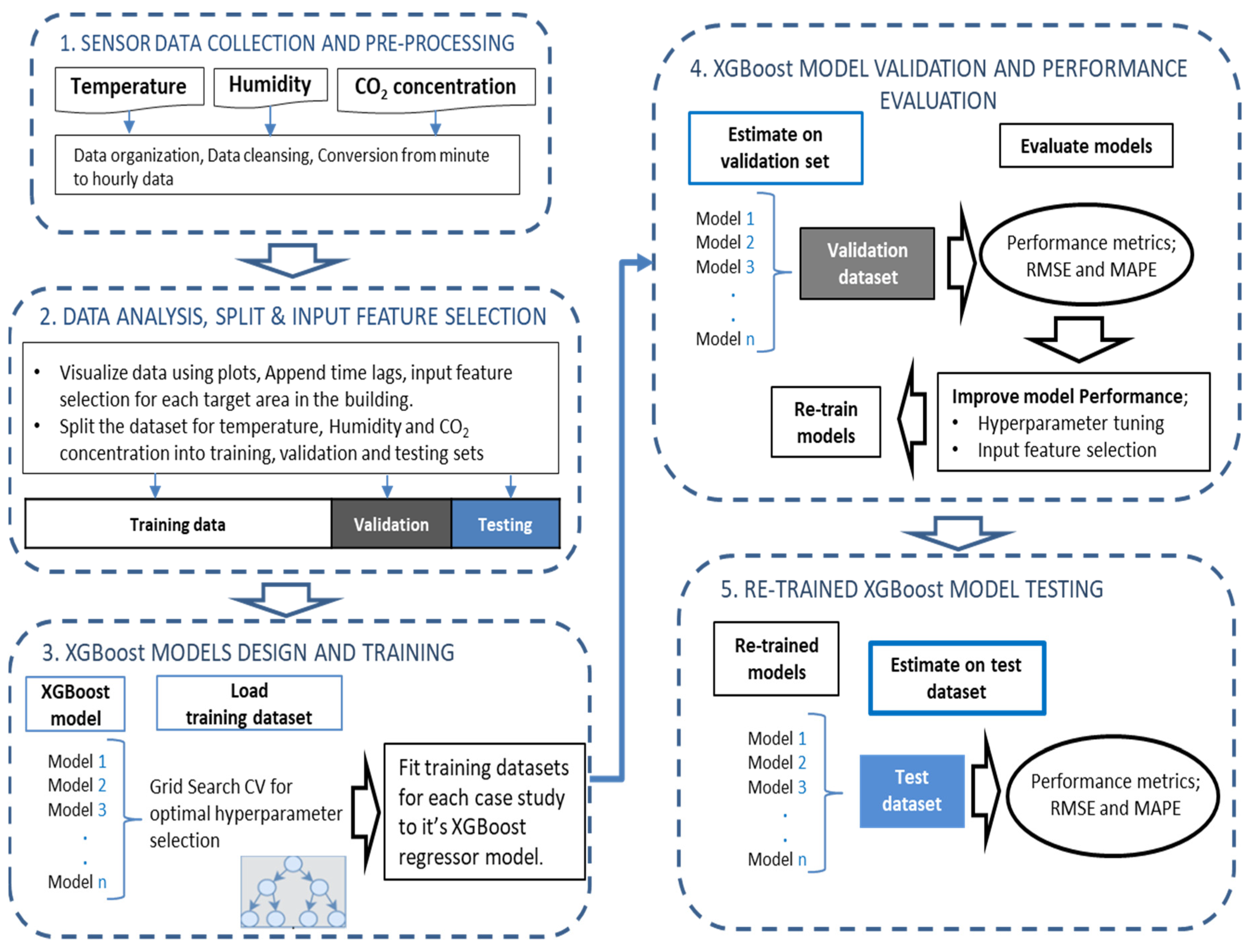
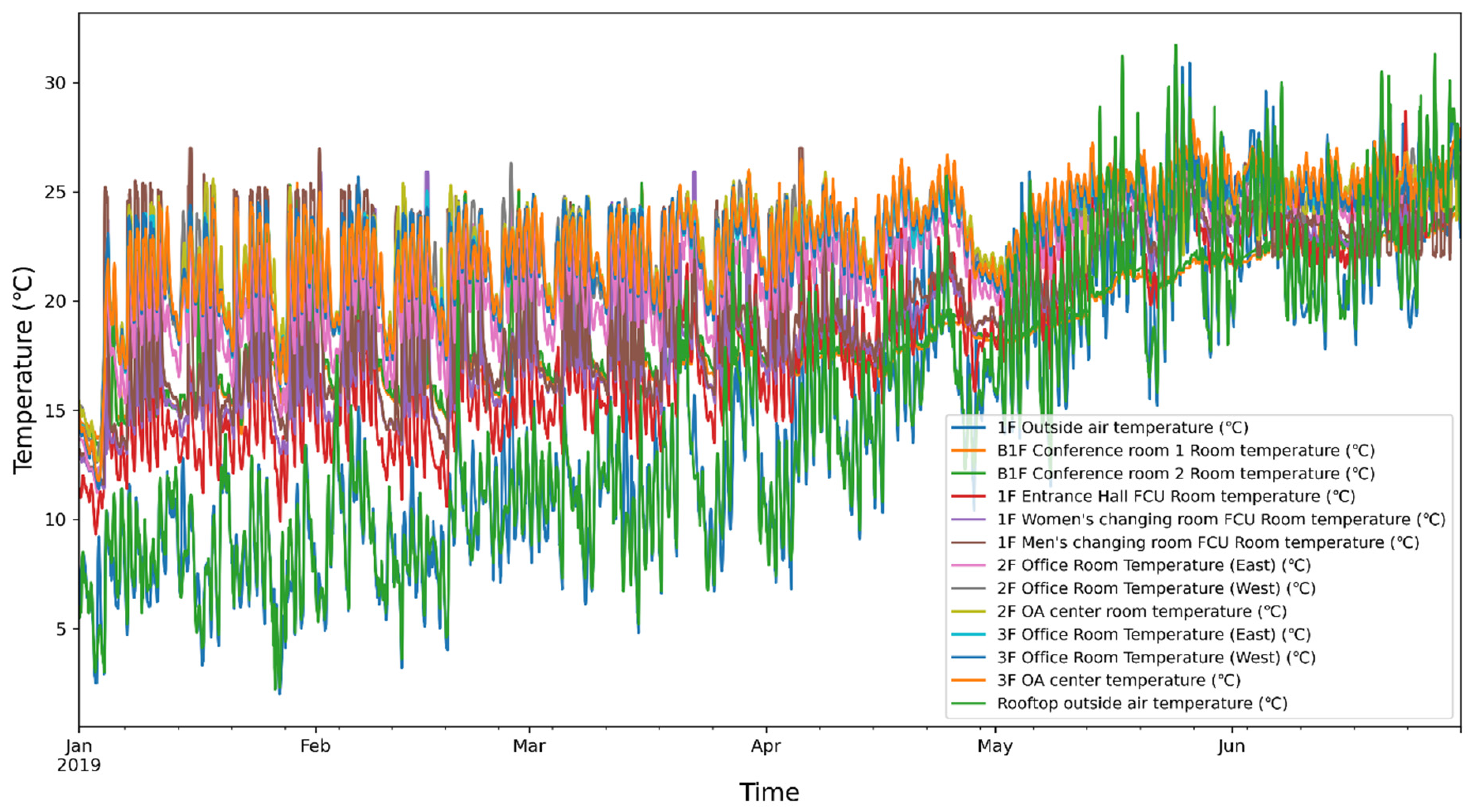
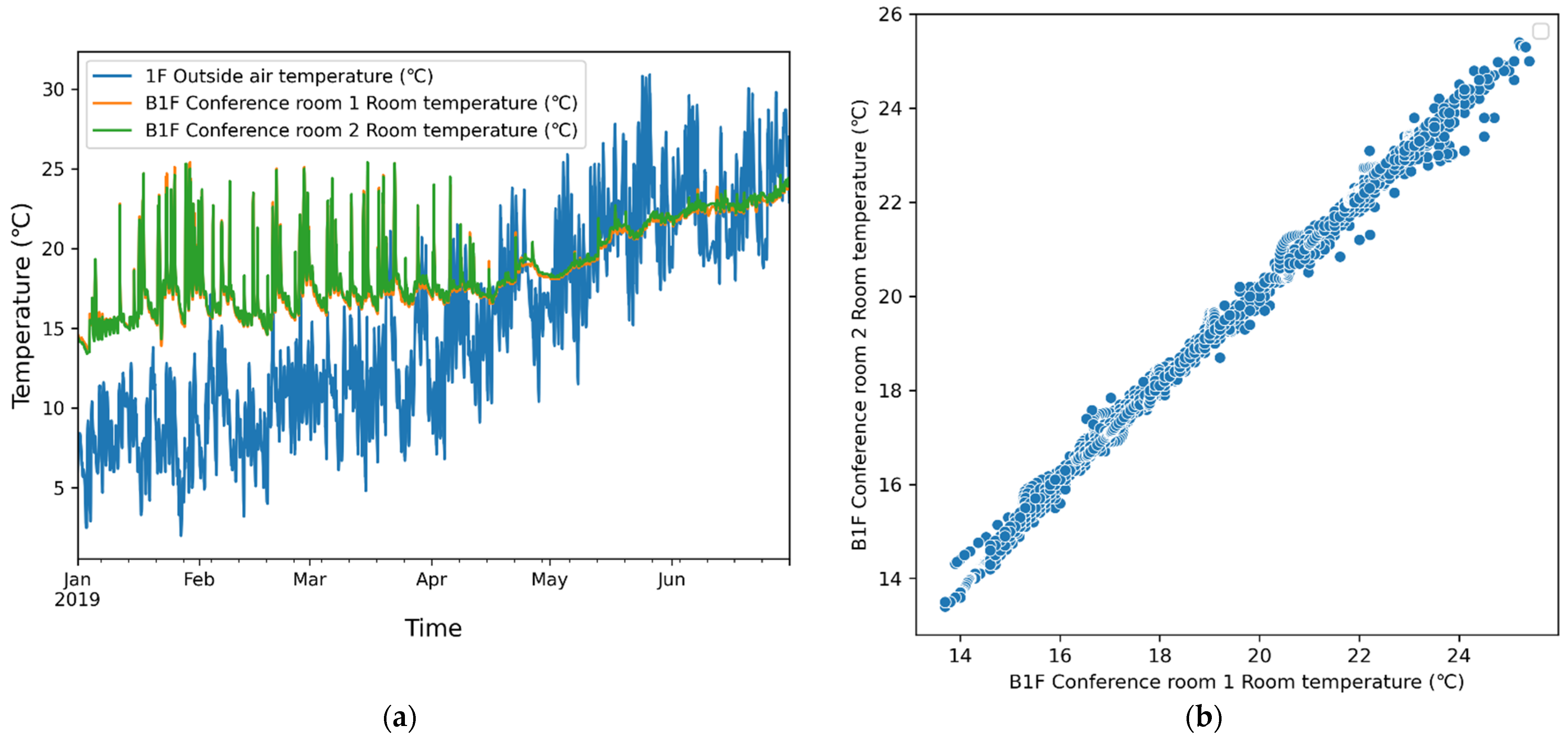


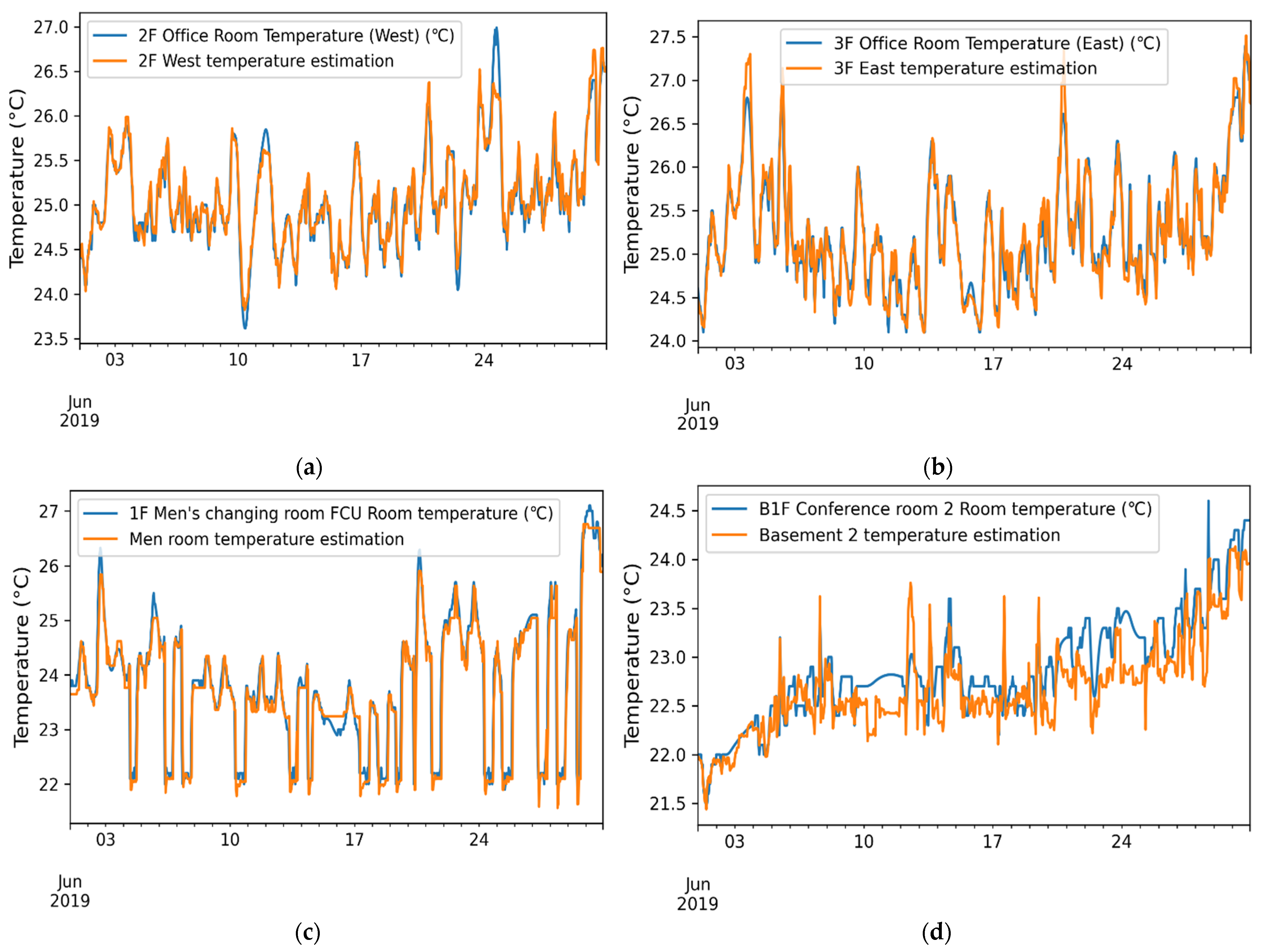
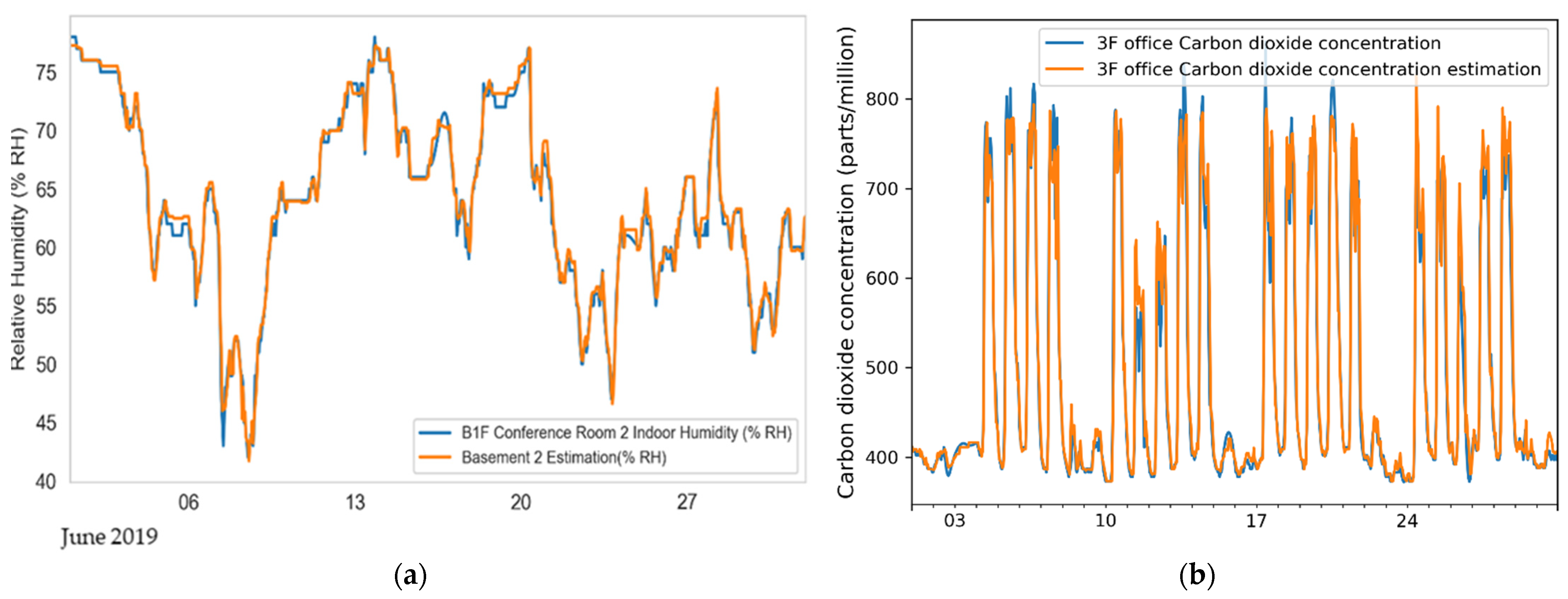
| Hyperparameter | Model 1 | Model 2 | Model 3 | Model 4 | Model 5 | Model 6 | Description |
|---|---|---|---|---|---|---|---|
| max_depth | 4 | 2 | 4 | 3 | 2 | 2 | Maximum depth of each tree (1–10) |
| n_estimators | 400 | 50 | 200 | 400 | 400 | 400 | Number of trees in the ensemble |
| colsample_bytree | 1 | 1 | 1 | 1 | 1 | 1 | Number of features used in each tree |
| min_child_weight | 1 | 1 | 1 | 1 | 1 | 1 | Minimum sum of weight needed in a child |
| learning_rate | 0.3 | 0.3 | 0.3 | 0.3 | 0.3 | 0.3 | The learning rate used to weigh each step |
| Selected Building Rooms | Validation RMSE | Test RMSE | Test MAPE |
|---|---|---|---|
| B1F Conference room 2 | 0.2101 | 0.4632 | 1.0656 |
| 1F Men’s changing room | 0.3741 | 0.4340 | 0.9707 |
| 2F Office Room (West) | 0.2906 | 0.1467 | 0.4204 |
| 2F OA center room | 0.3312 | 0.3134 | 0.8392 |
| 3F Office Room (East) | 0.4236 | 0.1736 | 0.5060 |
| 3F OA center | 0.3155 | 0.2436 | 0.6374 |
| Selected Building Rooms | Relative Humidity RMSE | Relative Humidity MAPE | CO2 Conc. RMSE | CO2 Conc. MAPE |
|---|---|---|---|---|
| B1F Conference Room 2 | 1.0992 | 1.1175 | 19.2314 | 1.5552 |
| Cool Pit | 2.9769 | 2.2044 | N/A | N/A |
| 2F Office Room (East) | 2.9958 | 2.5130 | N/A | N/A |
| 2F OA center room | 3.1536 | 2.696 | N/A | N/A |
| 3F Office Room (West) | 2.9958 | 2.4096 | 33.3331 | 3.3610 |
| 3F OA center | 2.7648 | 2.4707 | N/A | N/A |
Publisher’s Note: MDPI stays neutral with regard to jurisdictional claims in published maps and institutional affiliations. |
© 2022 by the authors. Licensee MDPI, Basel, Switzerland. This article is an open access article distributed under the terms and conditions of the Creative Commons Attribution (CC BY) license (https://creativecommons.org/licenses/by/4.0/).
Share and Cite
Kaligambe, A.; Fujita, G.; Keisuke, T. Estimation of Unmeasured Room Temperature, Relative Humidity, and CO2 Concentrations for a Smart Building Using Machine Learning and Exploratory Data Analysis. Energies 2022, 15, 4213. https://doi.org/10.3390/en15124213
Kaligambe A, Fujita G, Keisuke T. Estimation of Unmeasured Room Temperature, Relative Humidity, and CO2 Concentrations for a Smart Building Using Machine Learning and Exploratory Data Analysis. Energies. 2022; 15(12):4213. https://doi.org/10.3390/en15124213
Chicago/Turabian StyleKaligambe, Abraham, Goro Fujita, and Tagami Keisuke. 2022. "Estimation of Unmeasured Room Temperature, Relative Humidity, and CO2 Concentrations for a Smart Building Using Machine Learning and Exploratory Data Analysis" Energies 15, no. 12: 4213. https://doi.org/10.3390/en15124213
APA StyleKaligambe, A., Fujita, G., & Keisuke, T. (2022). Estimation of Unmeasured Room Temperature, Relative Humidity, and CO2 Concentrations for a Smart Building Using Machine Learning and Exploratory Data Analysis. Energies, 15(12), 4213. https://doi.org/10.3390/en15124213






